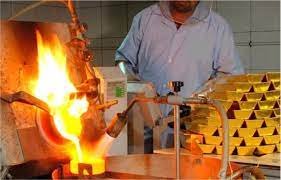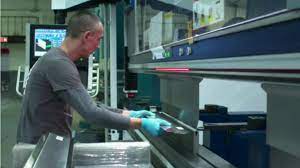Supervisor-Cleaning & Polishing
SECTOR: GEMS & JEWELLERY
SUB-SECTOR: Handmade gold and gems-set jewellery
OCCUPATION: Cleaning and Polishing
REFERENCE ID: G&J/Q0702
ALIGNED TO: NCO-2004/ NIL
Supervisor-Cleaning and Polishing: The cleaning and polishing supervisor is incharge of the day-to-day work flow and processes of cleaning and polishing
department.
Brief Job Description: The individual allocates work to subordinate workers, trains
and educate them, instructs about the job to be performed on daily basis, checks
quality of output and interacts with other department in order to ensure effective
cleaning and polishing of jewellery as per production planning and deliver on time.
Personal Attributes: The job requires the individual to have: attention to details;
good eyesight; and ability to manage a process driven team. The individual must
have ability to manage team and aptitude for improving the quality of output of
the team
Unit Code G&J/N0702
Unit Title
(Task) Supervise the cleaning and polishing department ‘s functions
Description This OS unit is about supervising the cleaning and polishing function in the gold
jewellery making process
Scope The unit/ task covers the following:
Deliver the jewellery to polisher and cleaner
Instruct on the polishing and cleaning requirement to polisher and cleaner
Monitor the polishing and cleaning function
Receive cleaned and polished jewellery and check quality
Control gold loss
Improve productivity of the team
Handle or report problems related to
Interact with Production Manager, frame and components’ goldsmiths,
polisher and other departments
Performance Criteria(PC) w.r.t. the Scope
Element Performance Criteria
Allocating and
monitoring work
To be competent, the user/individual on the job must be able to:
PC1. accurately assess worker’s capabilities and work load in order to distribute
work for maximum productivity
PC2. describe the job at hand to worker
PC3. instruct about precautions to be taken during the work
PC4. clearly define delivery schedule and work output requirements
PC5. anticipate and alert about any disruptions and worker’s capabilities
PC6. record the job sheet details for the cleaning and polishing of jewellery
PC7. allocate work to polisher and cleaner according to their work load and level of
expertise, e.g., some jewellery may require specific type of polishing which only
an experienced and skilled workmen can perform
PC8. instruct about the delivery time, tools and machines, and consumables to be
used and quality requirements
PC9. explain the hazards involved and precautions to be taken to avoid accidents
PC10. explain to subordinates the cleaning and polishing activity to be performed as
per requirement for the jewellery design
PC11. instruct about the use of magnetic tumbler, ultrasonic cleaner and other
equipment used in cleaning and polishing functions
PC12. instruct about the use of different polishing compounds available and their
utility
PC13. explain about different types of buffs such as metal, cloth, leather, wool, wood
and their use for different stages/types of polishing jewellery or components
PC14. instruct on the type of cleaning required for the jewellery or components
PC15. explain about different drying processes and instruct on the process to be used
for different types of jewellery
PC16. instruct on safety measures to be taken, example: instruct to use vacuum
bench polishing to avoid inhaling gold dust
PC17. instruct subordinates on gold loss and methods to control them
PC18. check that the polisher and cleaner are performing the work as per standard
process requirement
PC19. assist the subordinates on any critical activity as required
PC20. check that safety precautions are followed as per company’s policy
PC21. follow-up on compliance to the production plan
Quality checking To be competent, the user/individual on the job must be able to:
PC22. receive cleaned and polished jewellery after cleaning and polishing
PC23. perform visual quality check on all the jewellery received as per company
standards based on parameters such as weight, dimension, finish, shine,
impurities, marks
PC24. return the product for rework if they do not meet quality standards
PC25. account the number of jewellery received after cleaning and polishing
PC26. identify design related defects and report to Production Manager
PC27. identify any recurring defects and take steps to reduce them in order to
improve processes
Controlling gold loss
and achieving
productivity
To be competent, the user/individual on the job must be able to:
PC28. collect gold dispersed during the day (dust and fragments) from the
subordinates
PC29. tally account as per allowed standards for the design
PC30. conduct regular and controlled environment cleaning for collection
PC31. improve productivity of the team by allocating work after analysing
subordinates’ work load, expertise, skill level
PC32. take measures to improve speed of polishing while maintaining design quality
and gold loss standards
PC33. ensure that the output is achieved as per production planning
PC34. ensure that output is per company quality standards
PC35. anticipate any delays and inform production head in prior about the delay
Handling problems To be competent, the user/individual on the job must be able to:
PC36. report machine failure
PC37. assess and report shortage of consumables
PC38. assess and address workforce shortage
PC39. anticipate reasons for anticipated delays that may adversely affect
delivery
PC40. deliver complete product on time by reporting problems faced or
anticipated well in advance
PC41. handle technical and human resource problems in the department
Interactions with
superior and coworkers
To be competent, the user/individual on the job must be able to:
PC42. receive instructions from production head about deliverables and work flow
PC43. distribute work to cleaner and polisher
PC44. interact with production head to arrange for tools, machines, work space,
consumables and other facilities for the workers
PC45. give feedback to cleaner and polisher or other department on handling of
particular jewellery or order
PC46. receive instructions on quality check to be done from QC department and pass
the requirement them to cleaner and polisher
The individual on the job needs to know and understand:
KA1. company’s policies on: acceptable limits of precious metal loss per product
type, delivery timelines, safety and hazards, integrity and IPR, and personnel
management
KA2. work flow involved in jewellery manufacturing process of the company
KA3. management of worker, quality and productivity
KA4. conflict resolution and problem solving
KA5. performance appraisal
KA6. reporting structure
B. Technical
Knowledge
The individual on the job needs to know and understand:
KB1. jewellery making process and types of jewellery
KB2. different methods and techniques involved in cleaning and polishing and their
utilities
KB3. uses of different types of buffs for different types of polish to be achieved
KB4. effect of overheating during buffing on the jewellery
KB5. gemstone-setting, enamelling and plating process and their respective
polishing and cleaning requirements
KB6. different types of cleaning techniques such as magnetic tumbling, ultrasonic
cleaning, cyanide bombing, pickling cleaning and electro-cleaning
KB7. potential work hazards while using high speed rotating machines and
chemicals
KB8. operation and maintenance of different tools and equipments used in
cleaning and polishing activities
KB9. accounting of jewellery and documentation
KB10. team management
Skills (S) [Optional]
A. Core Skills/
Generic Skills
Basic reading and writing skills
The user/individual on the job needs to know and understand how:
SA1. reading about different types of jewellery and their properties
SA2. read weight, dimensions of the jewellery as given on job sheets
SA3. document work flow, quality standards and outcomes as per company policy
SA4. read company rules and compliance documents required to complete the work
Calculation and geometry skills
The user/individual on the job needs to know and understand how:
SA5. to assess gold loss at each step of jewellery making so as to deliver product of
correct weight and size
SA6. to translate finish and symmetry of design into Jewellery
The user/individual on the job needs to know and understand how:
SA7. to distribute work equitably and according to seniority and experience of
worker
SA8. to encourage workers to share workload and deliver on time
SA9. to assess worker requirements in terms of training, tools, machinery,
workspace and other facilities
SA10. to appraise based on company’s standards and workers’ performance
SA11. to encourage workers to multitask and work on different types of jewellery as
per their requirement
B. Professional Skills Communication skills
The individual on the job needs to know and understand how to:
SB1. give appropriate instructions and feedback to different levels of workers under
supervision
SB2. educate about safety and work hazards
SB3. train on gold loss, productivity and correct steps to follow on the job
SB4. inform about IPR issues pertaining to the company and detecting violations
SB5. resolve inter-personal conflicts between workers and co-workers
Using tools and machines
The user/individual on the job needs to know and understand how:
SB1. to use the right buff for achieving the finish as per design
SB2. to use the appropriate cleaning method, chemicals and machines for the stage
of cleaning
SB3. to understand safety procedures and hazards involved in polishing and cleaning
SB6. to maintain tools and buffs and what precautions are required in operating
them in terms of desired outcome and safety
SB7. to work in a safe environment, i.e., without injuries
Reflective thinking
The user/individual on the job needs to know and understand how to:
SB8. improve work processes for greater productivity
SB9. use correct posture for performing the job without injuring body parts
SB10. reduce gold loss
SB11. improve quality of output
Critical thinking
The user/individual on the job needs to know and understand how:
SB12. spot process disruption and reasons for delay
SB13. arrange for tools, machines and consumables in time
Unit Code G&J/N9910
Unit Title
(Task) Respect IPR of company as well as competitors
Description This OS unit is about maintaining company’s IPR and avoiding infringement on
copyright of others
Scope This unit/task covers the following:
Protect company’s Intellectual Property Rights (IPR)
Avoid infringement to copyright of other companies
Performance Criteria(PC) w.r.t. the Scope
Element Performance Criteria
Respecting IPR To be competent, the user/individual on the job must be able to:
PC1. prevent leak of new designs to competitors by reporting on time
PC2. spot any infringement of company’s product or design patents
PC3. report IPR violations observed in the market, to supervisor or company heads
PC4. read copyright clause of the material published on the internet and any other
printed material
PC5. consult supervisor or senior management when in doubt about using publicly
available information
PC6. report any infringement observed in the company
PC7. spot plagiarism and report
PC8. understand rationale of patents and IPR
PC9. avoid being involved in IPR violations
Knowledge and Understanding (K)
A. Organizational
Context
The individual on the job needs to know and understand:
KA1. company’s policies on IPR, plagiarism and order leaks
KA2. company’s patented products
KA3. market trends and company’s unique product range
KA4. reporting structure
B. Technical
Knowledge
The individual on the job needs to know and understand:
KB1. basics of patents and IPR laws
KB2. how IPR protection is important for competitiveness of a company
Skills (S) [Optional]
A. Core Skills/
Generic Skills
Communication skills
The user/individual on the job needs to know and understand how:
SA1. to effectively communicate any observed IPR violations or design leaks
B. Professional Skills Decision making
The user/individual on the job needs to know and understand when and how:
SB1. to report sources of IPR violations
The user/individual on the job needs to know and understand how:
SB2. to learn from past mistakes and report IPR violations on time
Critical thinking
The user/individual on the job needs to know and understand how:
SB3. to spot signs of violations and alert authorities in time
Unit Code G&J/N9914
Unit Title
(Task) Work towards having a safe work environment
Description This OS unit is about being aware of and communicating potential hazards and
dangers of accidents on the job
Scope This unit/task covers the following:
Understand potential sources of accidents
Communicate to reporting supervisor in time
Performance Criteria(PC) w.r.t. the Scope
Element Performance Criteria
Understanding of
potential sources of
accidents and
communicating
To be competent, the user/individual on the job must be able to:
PC1. avoid accidents related to use of potentially dangerous chemicals, gas torches,
sharp tools and hazards from machines
PC2. suggest process flow improvements to reduce anticipated or repetitive hazards
PC3. report mishandling of tools, machines or hazardous materials
PC4. identify electrical problems that could result in accident spot and report
potential hazards on time
PC5. follow company policy and rules regarding hazardous materials
PC6. deliver quality work on time as required by reporting any anticipated reasons
for delays
Knowledge and Understanding (K)
A. Organizational
Context
(Knowledge of the
company /
organization and
its processes)
The individual on the job needs to know and understand:
KA1. company’s policies on handling: harmful chemicals and sharp tools, safety and
hazards of machines, fire safety and, disposal of harmful chemicals and
materials
KA2. work flow involved in company’s jewellery manufacturing process
KA3. importance of the individual’s role in the workflow
KA4. reporting structure
B. Technical
Knowledge
The individual on the job needs to know and understand:
KB1. how different chemicals react and what could be the danger from them
KB2. how to use machines and tools without causing bodily harm
KB3. fire safety education
KB4. disposal of hazardous chemicals, tools and materials by following prescribed
environmental norms or as per company policy
Skills (S) [Optional]
A. Core Skills/
Generic Skills
Communication skills
The individual on the job needs to know and understand how:
SA1. to effectively communicate the danger
The individual on the job needs to know and understand:
SB1. importance of reporting potential sources of danger
SB2. appropriate actions to be taken in the event of an accident
SB3. procedure for disposing of hazardous materials, safely and following
environmental guidelines
Reflective thinking
The individual on the job needs to know and understand how:
SB4. to learn from past mistakes regarding use of hazardous machines or
chemicals or gas torches
Critical thinking
The individual on the job needs to know and understand:
SB5. how to spot danger
SB6. procedure to follow in the event of a fire or other hazard
Unit Code G&J/N9916
Unit Title
(Task) Interact with colleagues and seniors
Description This OS unit is about communicating with colleagues and seniors in order to maintain
smooth and hazard-free work flow
Scope This unit/task covers the following:
Interact with Production Manager or superior
Interact with colleagues within and outside the department
Performance Criteria(PC) w.r.t. the Scope
Element Performance Criteria
Interaction with
supervisor
To be competent, the user/individual on the job must be able to:
PC1. receive work-flow instructions and quality standards
PC2. communicate about process flow improvements, product defects, repairs and
maintenance of tools and machinery as required
PC3. communicate any potential hazards or expected process disruptions
PC4. understand the work output requirements
PC5. comply with company policy and rule
PC6. deliver quality work on time as required by reporting any anticipated reasons
for delays
Interactions with
colleagues and other
departments
To be competent, the user/individual on the job must be able to:
PC7. work as a team with colleagues and seniors
PC8. share skills and train
PC9. communicate and discuss work flow related difficulties in order to find
solutions with mutual agreement
PC10. receive feedback and address concerns in order to complete work on time
PC11. put team over individual goals
PC12. conflicts resolution and multi-tasking
Knowledge and Understanding (K)
A. Organizational
Context
(Knowledge of the
company /
organization and
its processes)
The individual on the job needs to know and understand:
KA1. company’s policies on personnel management
KA2. work flow involved in company’s jewellery manufacturing process
KA3. importance of the individual’s role in the workflow
KA4. reporting structure
B. Technical
Knowledge
The individual on the job needs to know and understand:
KB1. how to communicate effectively
KB2. how to build team coordination
The individual on the job needs to know and understand how:
SA1. to motivate team to work
SA2. to convince seniors about significant process changes
SA3. to share work load as required
SA4. to deliver product to next work process on time
B. Professional Skills Decision making
The individual on the job needs to know and understand:
SB1. how to report potential areas of disruptions to work process
SB2. when to report to senior and when to deal with a colleague depending on the
type of concern
Reflective thinking
The individual on the job needs to know and understand:
SB3. how to improve work process
Critical thinking
The individual on the job needs to know and understand:
SB4. how to spot process disruptions and delays
Keywords /Terms Description
Sector Sector is a conglomeration of different business operations having similar
business and interests. It may also be defined as a distinct subset of the
economy whose components share similar characteristics and interests.
Sub-sector Sub-sector is derived from a further breakdown based on the
characteristics and interests of its components.
Occupation Occupation is a set of job roles, which perform similar/ related set of
functions in an industry.
Function Function is an activity necessary for achieving the key purpose of the
sector, occupation, or an area of work, which can be carried out by a
person or a group of persons. Functions are identified through functional
analysis and form the basis of OS.
Sub-function Sub-functions are sub-activities essential to fulfil the achieving the
objectives of the function.
Job role Job role defines a unique set of functions that together form a unique
employment opportunity in an organisation.
Occupational Standards
(OS)
OS specify the standards of performance an individual must achieve
when carrying out a function in the workplace, together with the
knowledge and understanding they need to meet that standard
consistently. Occupational Standards are applicable both in the Indian
and global contexts.
Performance Criteria Performance criteria are statements that together specify the standard of
performance required when carrying out a task.
National Occupational
Standards (OS)
NOS are occupational standards which apply uniquely in the Indian
context.
Qualifications Pack (QP) QP comprises the set of OS, together with the educational, training and
other criteria required to perform a job role. A QP is assigned a unique
qualifications pack code.
Unit Code Unit code is a unique identifier for an Occupational Standard, which is
denoted by an ‘N’
Unit Title Unit title gives a clear overall statement about what the incumbent
should be able to do.
Description Description gives a short summary of the unit content. This would be
helpful to anyone searching on a database to verify that this is the
appropriate OS they are looking for.
Scope Scope is a set of statements specifying the range of variables that an
individual may have to deal with in carrying out the function which have
a critical impact on quality of performance required.
Knowledge and
Understanding
Knowledge and understanding are statements which together specify the
technical, generic, professional and organisational specific knowledge
that an individual needs in order to perform to the required standard.
Organisational Context Organisational context includes the way the organisation is structured
and how it operates, including the extent of operative knowledge
managers have of their relevant areas of responsibility.
Technical Knowledge Technical knowledge is the specific knowledge needed to accomplish
Core skills or generic skills are a group of skills that are the key to learning
and working in today’s world. These skills are typically needed in any
work environment in today’s world. These skills are typically needed in
any work environment. In the context of the OS, these include
communication related skills that are applicable to most job roles.
Keywords /Terms Description
IPR Intellectual Property Rights
NOS National Occupational Standard(s)
NVQF National Vocational Qualifications Framework
NSQF National Qualifications Framework
NVEQF National Vocational Education Qualifications Framework
QP Qualifications Pack









